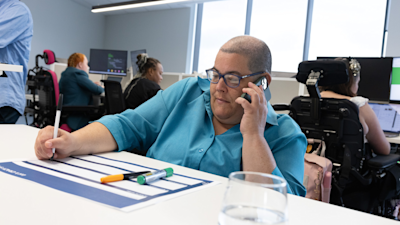Ashleigh Sternes, Diversity and Inclusion Lead at Life Without Barriers, reflects on the journey to disability pride.

Image: Ashleigh Sternes, Diversity and Inclusion Lead, wears a dark top and jacket, smiling at the camera. Text: Disability pride and finding disabled joy.
Ashleigh shares this story with us for Disability Pride Month. It is written in her own words.
The journey to disability pride and finding disabled joy is unique for everyone. I am Autistic and have lived experience of mental illness. As someone with invisible disabilities, stepping into my identity as a disabled person took time.
Here's what helped me get there.
Understanding the social model of disability
The social model of disability focuses on how society creates barriers for people with disability, in contrast to the medical model, which views disability itself as the problem. We need to change society, not disabled people.
I don't want to be 'fixed', 'cured' or 'saved'. I like that my Autistic brain works differently; I just wish society understood and accommodated that, too.
Acknowledging the diversity of the disability community
The 4.4 million Australians with a disability could have a physical, intellectual, mental, sensory, neurological, learning, or immunological disability. There's no definitive data on how many disabilities in Australia are invisible, but global estimates suggest it's around 80%.
Combatting internalised ableism
Whether people use the term disability to describe their identity or experience is a personal choice. What I would gently ask people who don't, though, is this: Is it because you have internalised the stereotypes and stigma society often associates with disability? Do you view disability as inherently negative or something to be ashamed of?
Two things can be true at once
Feeling pride and experiencing joy in my identity doesn't mean that sometimes things aren't hard. Interacting with a world not built for me, experiencing sensory sensitivity and dealing with the judgement of others can be tough. It doesn't mean I can't also celebrate my identity and experience as a disabled person.

Image: The disability pride flag created by writer Ann Magill, who has cerebral palsy.
Here's why it matters
Authenticity: It allows me to be authentically myself in the world and workplace—not a watered-down version checking part of myself at the door each day.
Healing: It gives me permission to be gentle with myself and work with my brain instead of against it.
Advocacy: It encourages me to advocate for myself and the inclusion of all marginalised people.
Community: I feel a sense of belonging, which allows me to participate in community building and collective care.
Visibility: It allows me to be the person I needed to see growing up. Representation matters.

Image: Two young women in wheelchairs travel down a pathway together.
Here's how to practice your allyship
Check your language: Use the word disability (no euphemisms, please—I'm looking at you 'differently abled'), and use inclusive language.
Challenge ableism: 'Calling in' and 'calling out' are widely used strategies to address harm like bias or discrimination and promote positive change.
Advocate for accessibility: Accessibility benefits everyone and applies to physical and digital spaces.
Are your emails and documents accessible?
Is your website or software accessible?
Are your meetings and events accessible?
Once you become aware of how inaccessible the world can be, you might, like me, develop an accessibility spidey-sense and pick up on inaccessibility everywhere. Use it to encourage the people around you to practice accessibility, too.
Use a person-centred intersectional approach: People are not just one thing. I'm a queer, disabled woman. I also really like cats and reading! Queerphobia, ableism, and sexism can overlap and increase the ways I might experience exclusion.

Image: Life Without Barriers staff and the people we support at Mardi Gras 2024.
Don't treat everyone the same: Often, in our intent to be 'fair' or base our decisions or approach on 'merit', we ignore that everyone has different needs, experiences, and opportunities.
Approach conversations with openness and empathy: Ask people with a disability what they need instead of making assumptions or decisions for them.
Adjust the work environment: Help your team do their best work. Leaders, talk to everyone in your team (not just the employees who have shared that they have a disability) about what they need to thrive in their roles. The recent pandemic changed the way we work almost overnight.
Ask yourself, is the change really too hard or just different from how we've always done things?
At Life Without Barriers, we celebrate diversity, and we practice inclusion. We believe in the strength of a diverse workforce where the perspectives and life experiences of our people help us build strong relationships with the people we support.
We are committed to creating change for people with disability, by people with disability. The Life Without Barriers 2022-2025 Access Inclusion and Employment Plan (AIEP) commits us to improving access and creating employment without barriers for people with disability within our organisation and by using our influence to see other organisations do the same. Central to the AIEP is the target to have 15% of its workforce comprised of people who identify as having a disability in the next three years.
The disability community is wonderfully diverse; Ashleigh acknowledges that she is one voice among many and uses identity-first language.


